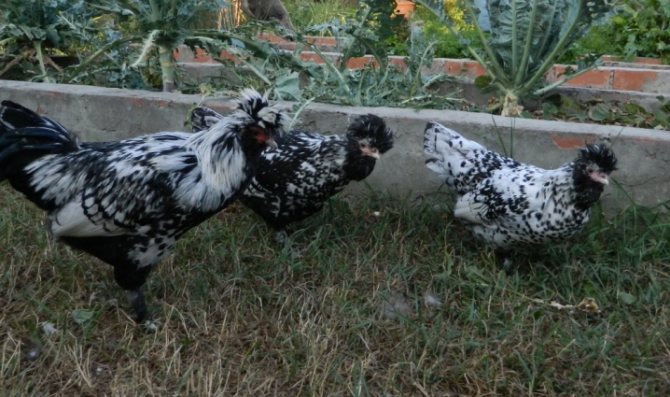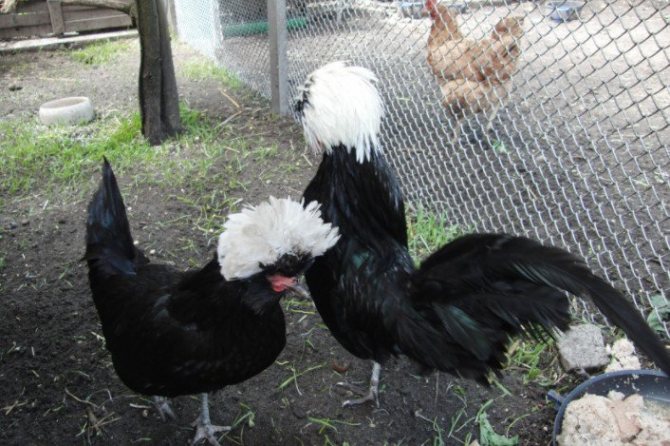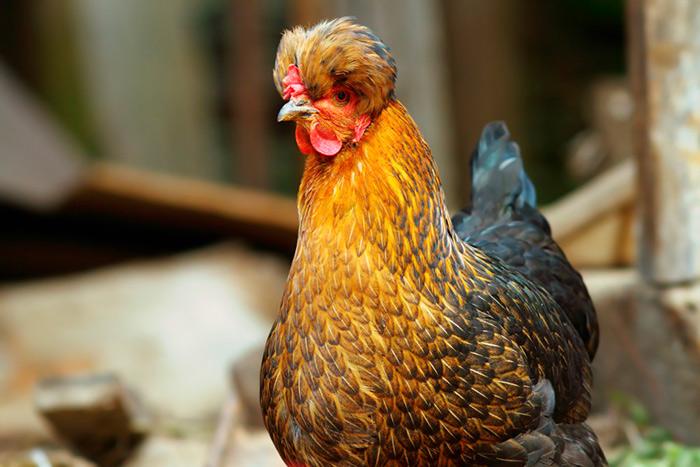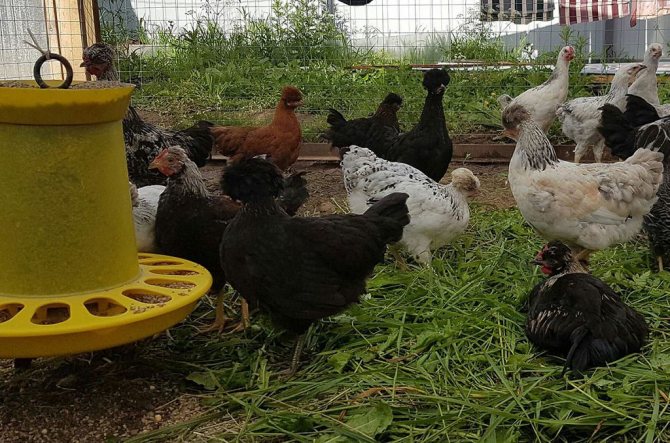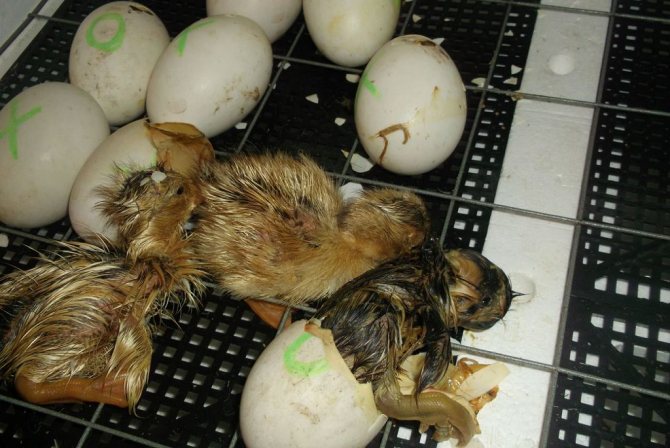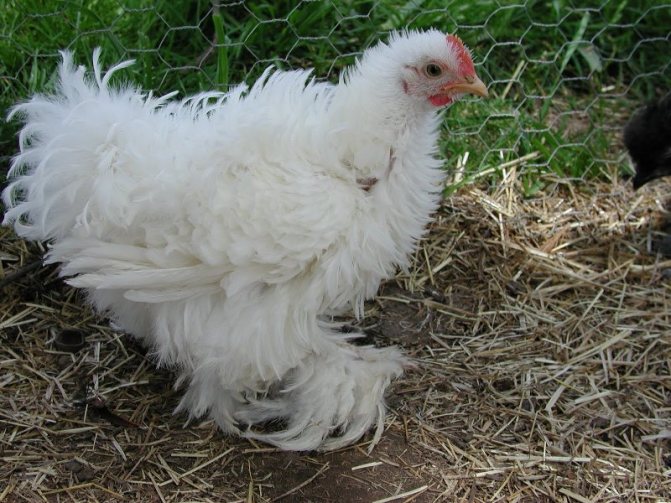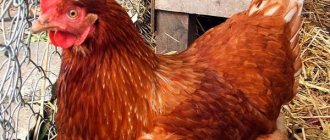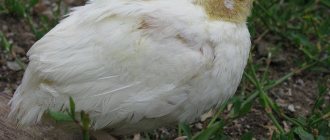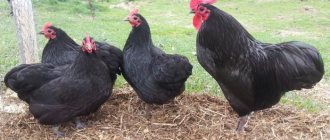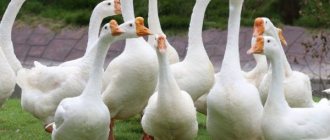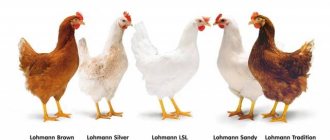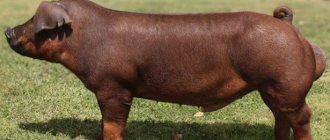The Russian crested breed of chickens is considered hardy, has a strong immune system. It is because of this that it has become very popular among professionals and amateurs of poultry breeding. Among all the 80 known poultry breeds that have been bred through natural selection, this breed is one of the most popular.
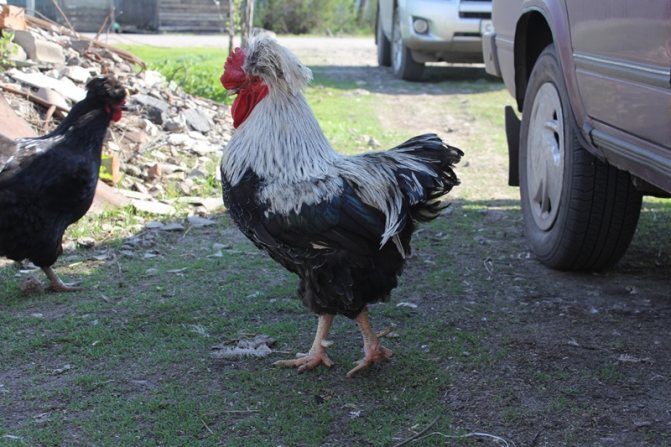
The Russian crested breed of chickens is considered hardy, with a strong immune system.
Description of the breed
Photo:
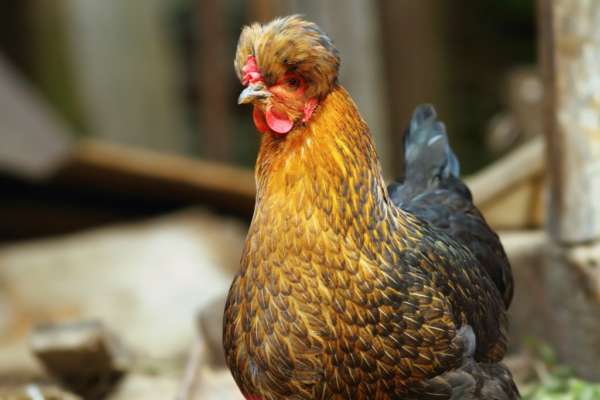

The Russian crested breed of chickens is widespread: it is grown on an industrial scale in large poultry farms, and in small farms, and in private farmsteads. And this is natural: this breed is one of the most hardy and unpretentious in keeping among all its brethren.
The fertility of eggs in the Russian Crested is very high - close to 100%. The safety of young animals is 90-92%, in adult birds it is even higher - 93-95%. And birds retain such indicators even if they are kept in an unheated poultry house.
Even in winter, these chickens prefer not to sit indoors, but to walk in the yard, "communicating" with other animals. This is genetically inherent in them: at the end of the 19th - beginning of the 20th centuries, the overwhelming majority of Russian peasants did not care about creating any comfortable conditions for these birds.
As a result, such "neglect" played a positive role in the life of birds, providing them with increased immunity to viral diseases, almost as strong as in wild birds, and the ability to quickly adapt.
Also, many years of stay in the same yard had a positive effect on the nature of the birds. They are inquisitive, friendly and get along without any problems with other species of birds: ducks, geese and their relatives from other breeds.
The Russian Crested is one of the most non-aggressive chicken breeds: even her cockerels get along well with each other and rarely arrange cock fights. Although, according to other sources, adult Russian Crested roosters are quite pugnacious, and this is even considered one of the shortcomings of the breed.
The original appearance of Russian crested chickens contributed to the fact that they are often bred not only for food needs, but also as an ornamental breed.
Maintenance and care
As a result of natural selection, chickens have developed a powerful immunity at the genetic level, which makes life much easier for farmers and owners. The breed is resistant to infectious diseases, which makes it similar in survival rate to wild birds.
Important! It is worth considering the high factor of attacks by wild animals. The coop should be protected by a deep-rooted fence that will prevent animals from digging.
Due to their capabilities, the owners can provide the most comfortable conditions for keeping birds. First of all, these are:
- large spacious chicken coop;
- insulated floor;
- ventilated area, windows;
- convenient organization of feeders and perches.
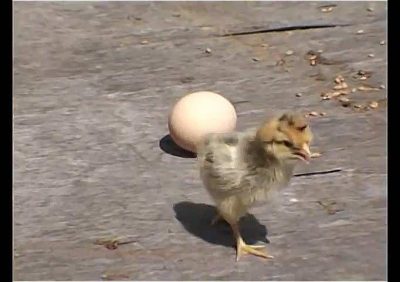

Distinctive features of the breed
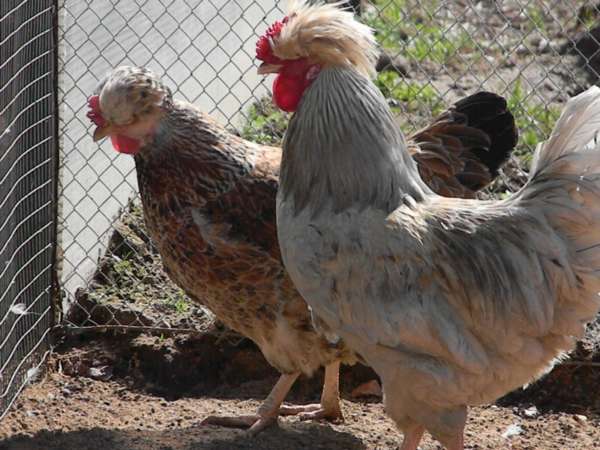

The main highlight of the Russian Crested is the large crest on the head. It has the same structure in both hens and roosters, protruding forward and covering part of the ridge.
Because of this feature, as well as because of the almost identical size of the birds, at first glance, it is even difficult to distinguish where the chicken is and where the rooster is.In addition to the crest, the distinctive features of the Russian Crested breed are red eyes and a slight bend in the end of a strong beak.
Birds have strong short legs with massive tibiae, abundant plumage, tight to the body and relatively short in relation to other breeds of chickens, erect tails.
In hens, the crest is slightly larger and thicker than in roosters; moreover, in hens it grows spherically, and in roosters it looks more like a disheveled mane and often hangs to one side.
In shape, the crest can be:
- rounded;
- helmet-shaped;
- sickle;
- spreading;
- sticking out.
A crest grows from a special tubercle on the head of birds - the so-called. visceral hernia. This bump of skin on the head is filled with brain, and thanks to it the Russian Crested is considered one of the smartest chicken breeds.
Other sex differences include a wider body and larger wings of a rooster, as well as longer legs in comparison with a chicken. Chickens and cockerels differ in the structure of the tail: in a rooster, it has curved braids and is always fluffed.
The wings of the Russian Crested are strong and always slightly lowered. Although the latter trait is more noticeable in males than in chickens.
Also, the exterior of the birds of this breed is characterized by a wide straight back and scarlet earlobes and "earrings", because of which among specialists in relation to the Russian Crested breed the definition of "red face" was fixed, which is also considered one of the main signs of the purity of the breed.
The Russian Crested does not have a specific standard color.
It can be pure white, black or red, as well as combined with the addition of other colors and shades to the base in various proportions. This is due to the fact that the Russian crested appeared almost spontaneously, and therefore it does not have one dominant color.
But on the other hand, there are a number of signs according to which breeders are culling birds that do not meet the standards of the Russian Crested:
- hypertrophied large ridge;
- white earlobes;
- little crest.
Although at present there is a revision of the standards of the Russian Crested and Pavlovskaya breeds, initiated by the Club of fans of these chickens.
In my opinion, this is quite justified: over the past century, nature has not stood still, and the exterior of the birds has changed noticeably.
Diseases
The bird has strong immunity and, if properly kept, does not suffer from diseases. Corydalis may have health problems mainly due to mistakes in care, or if the pets are already old.
There are no diseases typical for these chickens. In the absence of vaccinations, they can be affected by viral infections only if there is a strong epidemic, and the bird is weakened due to improper maintenance.
If the barn is damp, chickens can suffer from joint diseases. Because of this, they begin to limp and fall to their feet. If, in such a situation, the contents are not normalized at the first manifestations of ill health, it will not be possible to save the chickens.
Origin story
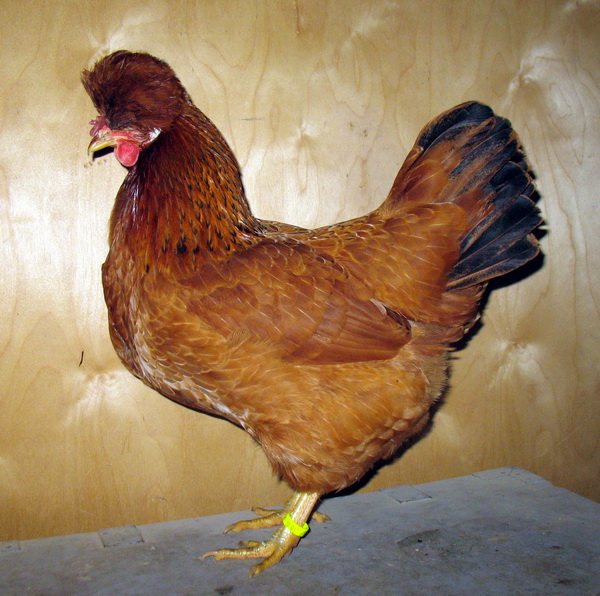

The Russian crested is a vivid example of folk selection. It appeared on the peasant farmsteads of the Russian Empire at the end of the 19th century. It is interesting that around the same time, chickens, very similar to the Russian Crested breed, appeared in Asian countries.
It is now impossible to establish whether the ancestors of the Russian Crested were imported from Asia or whether the Russian Crested were in Asia, contributing to the development of a new breed. Still, most experts are inclined to the "Russian" origin of this breed.
The ability to tolerate severe frosts has never been a hallmark of Asian chicken breeds, while purely Russian breeds adapt without any problems to the hot climate of Asian countries.
Today the Russian Crested is bred in Russia, most of the post-Soviet republics and some Asian countries. You can find Russian Corydalis in the countries of central and even Western Europe, but their livestock there is insignificant.
Productive indicators
The Russian Crested is considered a meat and egg breed. For the meat direction, roosters are more suitable, gaining weight up to 3-3.5 kg. The weight of adult hens rarely "reaches" up to 2.5 kg, fluctuating in the range of 1.8-2.2 kg, so it is more expedient to use them as laying hens.
Productivity of a young chicken - 150-170 pcs. eggs per year. The average weight of 1 egg is about 57 g, the color of the shell is most often pinkish-cream, although sometimes it can be white or dark beige.
Most chicken crosses (hybrids) differ in increased egg production in their first season, and then sharply reduce it. In contrast to them, the Russian Crested, being a purebred breed, retains high egg production rates for 3-4 years, although it decreases them in comparison with the first season.
But this decrease in productivity is fully compensated for by a highly developed maternal instinct.
Therefore, when breeding the Russian Crested breed of chickens, you can do without incubators and other technical devices. And it is understandable: at the time when it appeared, such technical achievements did not exist in principle.
Food
In matters of feeding, they are unpretentious, in the summer they can forage themselves. To maintain the decorativeness of the plumage, small shells, chalk, as well as animal proteins and bone meal must be added to the feed.
- Stern
- Recipes
- Additives
Compound feed pk-1
Description of feed for egg breeds. Feeding instructions for laying hens
To read
Compound feed pk-2 and pk-3
Mineral and vitamin compositions, feeding rates
To read
Compound feed pk-4
Used to feed 15-17 weeks old laying hens
To read
Compound feed pk-5
Composition and instructions for feeding broiler chickens
To read
Purina® Pro
Important differences from the previous line, application schemes Start, Growth, Finish
To read
Barley and wheat for laying hens
Sprouting and steaming barley and wheat for chickens: how to do it right and how to give it to layers
To read
Broiler Wheat
Rules for feeding broiler chickens with wheat. Dosage for chickens from the second day of life and adult birds
To read
Mash
Making a broiler mash at home
To read
Rice and buckwheat
How and in what form can rice and buckwheat be used for feeding chickens. Standards for adult birds and chickens
To read
Bread
What bread can you feed chickens and how to do it correctly
To read
A fish
The product is given in limited quantities: overfeeding can cause serious harm to poultry.
To read
a piece of chalk
Chalk as a food additive for chicken feed. Feeding rates for chickens, young stock and laying hens
To read
Meat and bone meal
Meat and bone meal is a mandatory supplement for chicken feeding, containing protein and fats of animal origin
To read
Fish fat
How to feed fish oil to chickens, layers and broilers. What is the use of the drug and are there any contraindications
To read
Limestone
Limestone (dolomite) flour in the diet of chickens. Advantage over chalk and stern shell
To read
Salt
Daily dosage of salt for adult birds and young animals and cases of unwanted use
To read
Price
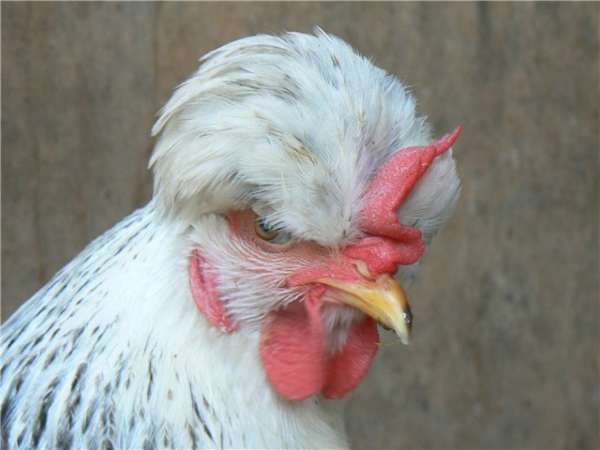

In specialized nurseries, the price for 1 bird of the Russian Crested breed can reach up to 1,500 rubles. and even more. Young animals of this breed can be purchased from hands on the market for 600-800 rubles, but it is hardly possible to talk about the species purity of such an acquisition.
Small chickens of this breed can be purchased at a price of 250 - 300 rubles per head. The cost of 1 egg for incubation is 50-60 rubles.
Character


Russian crested
Crested chickens are active. When free-range, they prefer to move quickly.Staying outdoors, poultry can take off to a height of 1-2 meters. The character is restless, while both males and females are not aggressive and quickly become attached to people.
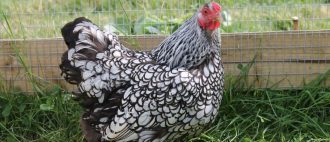

Be sure to read:
Chickens of the Wyandotte breed - decorative appearance and excellent productivity
Reviews of the Russian crested
The reviews from the owners of Russian Corydalis are almost entirely positive. People are captivated by the friendliness and intelligence of birds, their attachment to their owners and the ability to understand them, as they say, from a half-word.
Many note that, unlike most chicken breeds, Russian Crested birds are more attached to the owner than to the place. This nuance plays an important role if you need to move to a new place of residence.
It is also noted that laying hens are able to thank the owners with a significant increase in egg production for good care. There are even statements that layers of this breed carry 200-210 eggs per year in comfortable conditions.
Birds of the Russian Crested breed have good immunity and rarely get sick. Rare cases of bird disease are associated more with the mistakes of the owners in their maintenance. In addition, Corydalis are caring mothers, and when breeding them, you can do without an incubator.
As a relative disadvantage, almost all owners note the excessively noisy behavior of birds. But you can put up with this drawback, especially if you remember that these chickens carry a decent amount of eggs and are sources of delicious meat.
Adult family menu
Further feeding should be carried out based on the daily needs of the winged herd. Hens need nutritious food, plenty of calcium and vitamins. Males can consume everything the same as before, because the needs of their organisms are somewhat different. See below for dietary recommendations for adult birds.
- Beautiful plumage requires taking care of it, which partly lies in the correct structure of the diet. In order for the feathers to be shiny, lush and retain their decorative effect, fats should be added to the diet daily. Fish oil is also good because it supports the laying hens' immune system. There is no need to worry about the fact that the family will get fat from such food - due to the increased level of activity, this does not threaten them.
- Cereals should also be varied, and for this reason, preference should be given to ready-made combined mixtures.
- To provide the family with greenery all year round, you need to start harvesting it in the warm season. It is convenient to store dried herbs in the form of herbal flour or granules. After drying, the greens retain 90% of the nutrients, so they can be used to enrich the diet every day.
- Wet mash is good at any time of the year. But, during the period of stable cold weather, they are given immediately after cooking, in a warm state. This is necessary so that the porridge does not freeze, and so that the winged family can warm up a little while absorbing food.
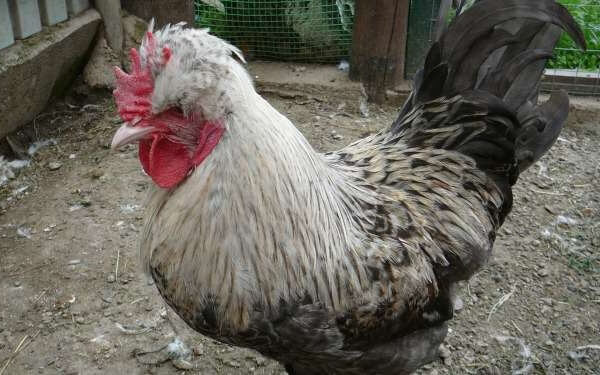

Breeding features
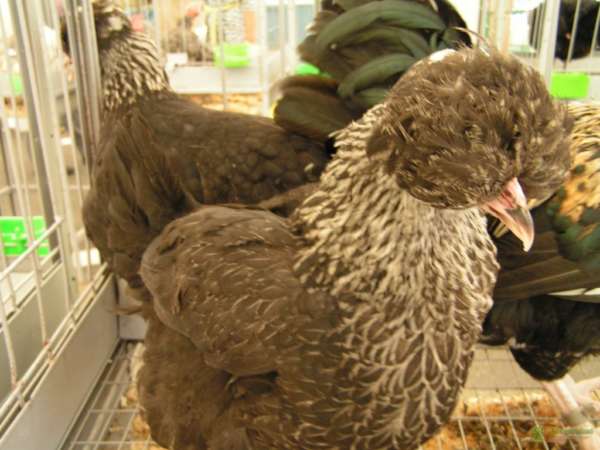

When breeding chickens of the Russian Crested breed, 2 points must be taken into account:
- Birds of this breed are extremely sociable and noisy. If something disturbs or agitates them, then their shout in the yard will stand for 1.5-2 hours. In addition, they quickly get used to their owners and, as they say, constantly get underfoot. Therefore, the place for the poultry yard should be arranged as far from the house as possible so that the chicken op will annoy less. And when moving around the bird thief, you need to carefully look at your feet all the time, so as not to cripple the birds.
- Russian Corydalis are capable of flying over 1.5-meter fences. And after flying, they often go for a walk around the neighborhood. Therefore, if you plan to keep the Russian Crested breed, the fence around the poultry yard should be at least 1.8 m in height.Otherwise, you will have to constantly find your pets, and not always successfully.
To breed the breed, you need to take eggs from layers at least 10 months old. When incubating eggs in the incubator, eggs of the correct shape and medium size are selected for setting.
The incubator should be laid no earlier than the end of February and no later than the beginning of July, so that the hatched chickens have time to fledge before the cold weather. The term for incubation of chickens is standard - 21 days. There is one caveat: from 20 to 30% of hatched chicks are born without a tuft.
Young animals should be admitted to an adult herd no earlier than at the age of 3.5 months. It is better to do this late in the evening, in fact at night, so that adult and young birds are saturated with the same smell by morning. Thus, it is possible to avoid the aggression of "old people" in relation to young birds.
Feeding
The maintenance of crested chickens provides for feeding three times a day with high-quality, sufficient food in volume, constant access to clean water. Adult birds are capable of foraging while walking, but the main diet is formed from grains, vegetables and chopped greens.
Corydalis include:
- coarsely crushed wheat, occasionally oats or barley;
- boiled potatoes, crushed with bran;
- steamed corn;
- compound feed for birds;
- chopped seasonal vegetables - cucumbers, zucchini, pumpkin;
- seasonal greens - finely chopped grass or nettles, tops, feathers and arrows of garlic, green onions, dandelion leaves;
- in winter, it is advisable to give dried nettles and chopped hay;
- crushed chalk or eggshells;
- crushed shell rock or coarse sand.
The required amount of feed for the kept livestock can be established by observation - the proposed amount should be eaten in 30 minutes.
Correct calculation is important to improve the efficiency of keeping chickens.
Corydalis are undemanding to the composition of the feed, but its usefulness ensures high productivity of chickens - up to 190 eggs per year. They are capable of laying eggs up to four years of age, although not as well as young layers.




